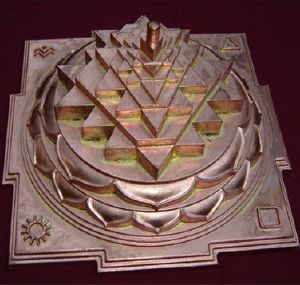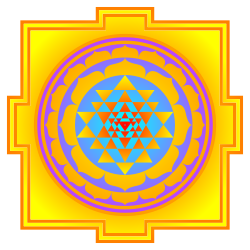Yantra
Yantra (fromSanskrit root यन्त्र् yam, meaning "to restrain, curb, check") refers to "any instrument or machine", "an amulet, a mystical or astronomical diagram used as an amulet."[1] "any instrument for holding, restraining, or fastening, a prop, support, barrier"; "any instrument or apparatus, mechanical contrivance, engine, machine, implement, appliance"; "restraint, force"; "an amulet, mystical diagram supposed to possess occult powers", see: Monier-Williams 1899, p. 845.</ref>
In addition, some Hindu esoteric practitioners employ yantra, mantra and other items in their sadhana, puja and yajna.[2]
Yantra, or other permutations and cognate phenomena such as Mandala, Rangoli, Kolam, Rangavalli and other sacred geometrical traditions, are endemic throughout Dharmic Traditions.
Sacred Geometry
Sacred geometry involves a complex system of hallowed attribution and signification that may subsume religious and cultural values to the fundamental structures and relationships of such complexes as space, time and form. According to this discipline, the basic patterns of existence are perceived as sacred: for by contemplating and communing with them one is thereby contemplating the Mysterium Magnum, the patterning relationships of the Great Design. By studying the nature of these patterns, forms and relationships and their manifold intra- and interconnectivity one may gain insight into the scientific, philosophical, psychological, aesthetic and mystical continuüm. That is, the laws and lore of the Universe.
The term sacred geometry is also used for geometry which is employed in the design of sacred architecture and sacred art. The underlying belief is that geometry and mathematical ratios, harmonics and proportionality discoverable from geometry also gird music, light, cosmology, and other observable and sensate features of the Universe. This value system has been held throughout the World from time immemorial to prehistory, a cultural universal endemic to the Human Condition. Sacred geometry is the foundation of the design, architecture, fabrication and construction of sacred structures such as temples, mosques, megaliths, monuments and churches; sacred space such as altars, temenos and tabernacles; places of congregation such as sacred groves, village greens and holy wells and the creation of religious art, iconography and divine proportionality. Sacred geometry, art, iconography and architecture need not be monolithic and enduring, but may be temporary and yielding, such as visualization and non-permanent sandpainting and medicine wheels.
Symbolism

The Sri Chakra or Shri Yantra of Tripura Sundari is a yantra or mandala formed by nine interlocking triangles surrounding the bindu. Four of these triangles are orientated upright representing Shiva or the Masculine. Five of these triangles are inverted triangles represent Shakti or the Feminine. Because it is composed of nine triangles, it is also known as the Navayoni Chakra.[3]
Together the nine triangles are interlaced in such a way as to form 43 smaller triangles in a web symbolic of the entire cosmos or a womb symbolic of creation. Together they express Advaita or non-duality. This is surrounded by a lotus of eight petals, a lotus of sixteen petals, and an earthsquare resembling a temple with four doors.[3]
The Shri Chakra is also known as the nava chakra because it can also be seen as having nine levels. Each level corresponds to a mudra, a yogini, and a specific form of the deity Tripura Sundari along with her mantra. These levels starting from the outside or bottom layer are:[3]
- Trailokya Mohana, a square of three lines with four portals
- Sarvasa Paripuraka, a sixteen-petal lotus
- Sarva Sankshobahana, an eight-petal lotus
- Sarva Saubhagyadayaka, composed of fourteen small triangles
- Sarvarthasadhaka, composed of ten small triangles
- Sarva Rakshakara, composed of ten small triangles
- Sarva Rohahara, composed of eight small triangles
- Sarva siddhi prada, composed of 1 small triangle
- Sarvanandamaya, composed of a point or bindu
Ritual Functions
Yantra as astronomical map
Yantra is basically a diagram representing the astronomical position of the planets over a given date and time. It is considered auspicious in Hindu mythology. These yantras are made up on various objects i.e. Paper, Precious stones, Metal Plates and alloys. It is believed that if we, as humans, follow the basic principal of constantly concentrating on the representation, it helps you build Fortunes, as planets above have their peculiar Gravity which governs basic emotions and karma, derived to attain satisfaction. These yantras are basically made on a particular date and time depending on the prescribed procedures defined under vedas.
Yantra as portal of communion
Yantra in Sanskrit denotes "loom", "instrument" and "machine". Yantra is an aniconic temenos or tabernacle of deva, asura, genius loci or other archetypal entity. Yantra are theurgical device that engender entelecheia. Yantra are realised by sadhu through darshana and samyama. There are numerous yantra. Shri Yantra is often furnished as an example. Yantra contain geometric items and archetypal shapes and patterns namely squares, triangles, circles and floral patterns; but may also include bija mantra and more complex and detailed symbols. Bindu is central, core and instrumental to yantra. Yantra function as revelatory conduits of cosmic truths. Yantra, as instrument and spiritual technology, may be appropriately envisioned as prototypical and esoteric concept mapping machines or conceptual looms. Certain yantra are held to embody the energetic signatures of, for example, the Universe, consciousness, ishta-devata. Some Hindu esoteric practitioners employ yantra, mantra and other items of the saṃdhyā-bhāṣā (Bucknell, et. al.; 1986: p.ix) in their sadhana, puja and yajna. Though often rendered in two dimensions through art, yantra are conceived and conceptualised by practitioners as multi-dimensional sacred architecture and in this quality are identical with their correlate the mandala. Meditation and trance induction with Yantra are invested in the various lineages of their transmission as instruments that potentiate the accretion and manifestation of siddhi.
Khanna (2003: p.21) in linking Mantra, Yantra, Ishta-devata, and thoughtforms states:
Mantras, the Sanskrit syllables inscribed on yantras, are essentially 'thought forms' representing divinities or cosmic powers, which exert their influence by means of sound-vibrations.[4]
Notes
ReferencesISBN links support NWE through referral fees
- Khanna, Madhu (2003). Yantra: The Tantric Symbol of Cosmic Unity. Inner Traditions. ISBN-10: 0892811323 & ISBN-13: 978-0892811328
- Apte, Vaman Shivram (1965), The Practical Sanskrit Dictionary (Fourth revised and enlarged ed.), Delhi: Motilal Banarsidass Publishers, ISBN 81-208-0567-4
- Bucknell, Roderick & Martin Stuart-Fox (1986), ''The Twilight Language: Explorations in Buddhist Meditation and Symbolism, London: Curzon press, ISBN 0-312-82540-4
- Monier-Williams, Monier (1899), A Sanskrit-English Dictionary, Delhi: Motilal Banarsidass
- White, David Gordon (1996), The Alchemical Body: Siddha Traditions in Medieval India, The University of Chicago Press, ISBN 0-226-89499-1
External links
- Lalita Tripurasundari, the Red Goddess Retrieved Dec. 5, 2007.
- How to draw Sri Yantra Retrieved Dec. 5, 2007.
Credits
New World Encyclopedia writers and editors rewrote and completed the Wikipedia article in accordance with New World Encyclopedia standards. This article abides by terms of the Creative Commons CC-by-sa 3.0 License (CC-by-sa), which may be used and disseminated with proper attribution. Credit is due under the terms of this license that can reference both the New World Encyclopedia contributors and the selfless volunteer contributors of the Wikimedia Foundation. To cite this article click here for a list of acceptable citing formats.The history of earlier contributions by wikipedians is accessible to researchers here:
The history of this article since it was imported to New World Encyclopedia:
Note: Some restrictions may apply to use of individual images which are separately licensed.
